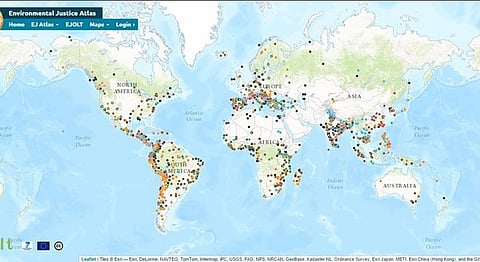
- HOMEGROWN WORLD
- #HGCREATORS
- #HGEXPLORE
- #HGVOICES
- #HGSHOP
- CAREERS
- ABOUT US
- CONTACT US

Earlier this year it was made official that in the 136 years of record keeping, 2015 was the hottest recorded year, beating 2014 by the widest margin. And then, January 2016 broke the record by claiming the title of ‘the most anomalously warm month’ ever. The month was 1.13°C above normal. Then, February 2016 broke destroyed all records. Not only were Arctic regions 16°C warmer than normal, but the Earth north of the equator was 2°C warmer than pre-industrial temperatures. With each day it is becoming glaringly obvious that the costs and consequences of climate change in our world will soon define life in the coming years.
Everyday, we are exhausting the Earth’s ability to absorb greenhouse gases. 2015 saw the largest annual increase in carbon dioxide since records began. The science is simple— we have been learning this since middle school— increase in carbon dioxide levels in the atmosphere means higher temperature.
Nations across the world have been talking about taking steps to cut down carbon emissions, but how far these plans have developed into something tangible is questionable. And, as far as studies suggest, even if these projects were executed, a warmer climate across the world is inevitable. There is no guarantee that even reverting to drastic measures such as geoengineering will work.
Climatic changes has far reaching multi-fold consequences— nations that lack the resources, good governance, and the resilience needed to face the many adverse consequences of climate change will lose stability forcing people from these regions to flee for refuge, which will result in conflicts. While it is difficult to fully understand the strong correlation between migration and economic and political instability, evidence shows that there is plenty of reason for authorities across the world to be concerned.
The EJAtlas and its findings:
In December 2015, the Environmental Justice Atlas released a map in Current Science that highlights ecological conflicts across the world. As per their research, India, Colombia and Nigeria shows the highest incidence of conflict caused by climate change and environmental disputes.
Between 2011-2015, the European Commission FP7 funded the Environmental Justice, Liabilities and Trade’ (EJLOT) project with aim of ‘bringing science and society together to catalogue and analyse ecological distribution conflicts and confront environmental injustice’. Under this project, they created the Environmental Justice Atlas or EJAtlas.org, an online interactive information portal that provides people with the various ‘cases of people’s’ resistance against climatic change and environment degradation’.
The Atlas has recorded conflicts at both local and national level, on varying issues such as nuclear energy, thermal power plants, mining, land acquisition and infrastructure, among other parameters. A small research team from Jawaharlal Nehru University in Delhi collected and documented accounts of environmental and ecological conflicts across South Asia. After compiling the information, the group created the map which showed that India is on the top of this list with more than 200 such recorded conflicts. Columbia with 101 and Nigeria with 71 takes the second and third spots in the list. Most recorded disputes in India are related to issues of water management, followed by that of fossil fuels, climate justice and the industrial and utilities conflicts.
According to V V Krishna, the project director and professor at the Centre for Studies in Science Policy at Jawaharlal Nehru University, New Delhi, one of the reasons why country shows maximum number of conflicts is the rapid industrialisation, mining for natural resources and industrial units that flout environmental guidlines. He also added that India is known for bad management of water resources. “This leads to shortage, leading to conflicts. There is also the appropriation of water sources and channels by industrial units with political nexus,” he said.
So far, the EJAtlas details 1,671 conflicts. Joan Martinez-Alier, professor at the Autonomous University of Barcelona, Spain and member of the EJOLT co-ordinating team, pointed out that many conflicts, especially in India, may be under-reported. “This is the largest country in the world in terms of population, and very likely in terms of environmental conflicts,” he says.
Krishna added that countries which are good at gathering and distributing evidence around climate change and resources tend to be better at avoiding violent conflict arising from these issues. “If there is a fit between knowledge generation and decision making, it helps,” says Krishna. “In India there is a very weak or no link between these two domains of policymaking.”
Each of the case listed in the atlas includes a structured detail of information such as description, basic data, source of conflict, project details and actors, the conflict and the mobilization, impacts, outcome, sources and materials, meta information and comments. Their aim is that students and policy makers study these cases to under their impact on the environment and society and therefore form laws that could prevent such instances.
What does this mean for us?
If we were to factor in El Niño to the other phenomenon that are causing climatic changes, then we can easily conclude 2016 that will continue to get warmer. But the political, callousness towards this problem is far more scarier. Neither the politicians nor the media seems to be giving enough importance to it. Despite being a pressing matter, the need for environmentally conscious changes has barely managed to gain worldwide attention. While there are very few who seem to have fully grasped the seriousness of the situation, as we suggested earlier on it might not make much of a difference in the long run. If the trend continues, we will be facing a very hot summer this year, and in the years that might follow.
Words: Krupa Joseph
